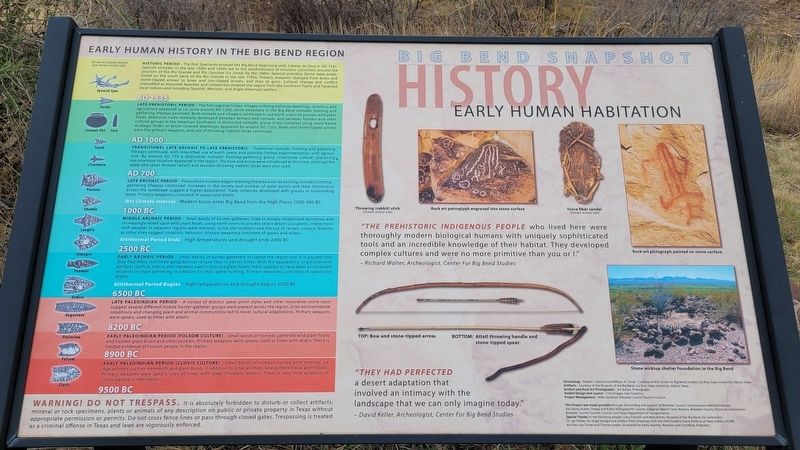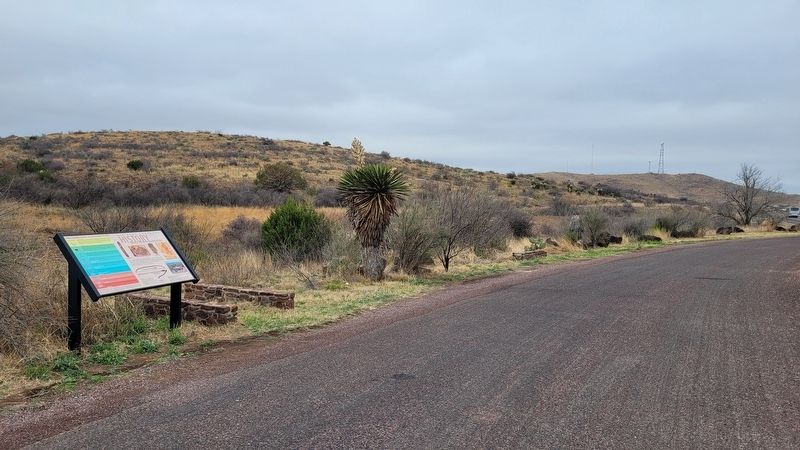Near Alpine in Brewster County, Texas — The American South (West South Central)
Early Human Habitation
Big Bend Snapshot History
Early Human History in the Big Bend Region
Historic Period - AD 1535 - The first Spaniards entered the Big Bend beginning with Cabeza de Vaca in AD 1535. Spanish entradas in the late 1500s and 1600s led to the establishment of missions (churches) around the junction of the Rio Grande and Rio Conchos (La Junta) by the 1680s. Spanish presidios (forts) were established on the south bank of the Rio Grande in the late 1700s. Primary weapons changed from bows and stone-tipped arrows to bows and iron-tipped arrows, and then to guns. Cultural change and conflict intensified as mounted Apaches and Comanches entered the region from the Southern Plains and harassed local Indians and intruding Spanish, Mexican, and Anglo-American settlers.
Late Prehistoric Period - AD 1000 - The first regional Indian villages utilizing pithouse dwellings, ceramics, and agriculture appeared at La Junta around AD 1200, while elsewhere in the Big Bend nomadic hunting and gathering lifeways persisted. Both nomads and villagers continued to use earth ovens to process wild plant foods. Extensive trade networks developed between farmers and nomads, and between farmers and other cultural groups in the American Southwest. A distinctive nomadic group (Cielo complex) using stone-based wickiups (hide- or brush-covered dwellings) appeared by around AD 1250. Bows and stone-tipped arrows were the primary weapons, and use of throwing (rabbit) sticks continued.
Transitional Late Archaic to Late Prehistoric - AD 700 - Traditional nomadic hunting and gathering lifeways continued, with intensified use of earth ovens and possibly limited experimentation with agriculture. By around AD 750 a distinctive nomadic hunting-gathering group (Livermore culture) practicing, mountaintop ritualism appeared in the region. The bow and arrow were introduced at this time, although the spear and spear thrower (atlatl) and wooden throwing (rabbit) sticks were also used.
Late Archaic Period - 1000 BC - Plains bison hunters began entering the area even as existing nomadic hunting-gathering lifeways continued. Increases in the variety and number of spear points and their distribution across the landscape suggest a higher population. Trade networks developed with groups in surrounding areas. Primary weaponry consisted of spears and atlatls.
Wet Climate Interval - Modern bison enter Big Bend from the High Plains 1000-300 BC
Middle Archaic Period - 2500 BC - Small bands of hunter-gatherers lived in loosely established territories and increasingly relied upon wild plant foods, using earth ovens to process select desert succulents. Interactions with peoples in adjacent regions
were minimal. Some site locations and the use of certain unusual features at other sites suggest ritualistic behavior. Primary weaponry consisted of spears and atlatls.
Altithermal Period Ends - High temperatures and drought ends 2000 BC
Early Archaic Period - 6500 BC - Small bands of hunter-gatherers occupied the region and it is posited that they had more restricted geographical ranges than in earlier times. With the appearance of groundstone artifacts (such as manos and metates) used to process plant foods, there appears to have been an increased reliance on plant gathering in addition to small game hunting. Primary weaponry consisted of spears and atlatls.
Altithermal Period Begins - High temperatures and drought begins 5000 BC
Late Paleoindian Period - 8200 BC - A variety of distinct spear point styles and other innovative stone tools suggest several different mobile hunter-gatherer groups were present across the region. Drier environmental conditions and changing plant and animal communities led to novel cultural adaptations. Primary weapons were spears, used at times with atlatls.
Early Paleoindian Period (Folsom Culture) - 8900 BC - Small bands of nomads gathered wild plant foods and hunted giant bison and other animals. Primary weapons were spears, used at times with atlatls. There is limited evidence of Folsom people in the region.
Early Paleoindian Period (Clovis Culture) - 9500 BC - Small bands of nomads hunted both terminal Ice Age animals such as mammoth and giant bison, in addition to small animals, and gathered wild plant foods. Primary weapons were spears, used at times with spear throwers (atlatls). There is very little evidence of Clovis people in the region.
(Arrow and spear points are shown actual size)
Spanish Spur
Perdiz
Ceramic Pot
Corn
Toyah
Livermore
Paisano
Shumla
Langtry
Almagre
Pandale
Andice
Angostura
Plainview
Folsom
Clovis
"The Prehistoric Indigenous People who lived here were thoroughly modern biological humans with uniquely sophisticated tools and an incredible knowledge of their habitat. They developed complex cultures and were no more primitive than you or I."
- Richard Walter, Archeologist, Center For Big Bend Studies
"They Had Perfected a desert adaptation that involved an intimacy with the landscape that we can only imagine today."
- David Keller, Archeologist, Center For Big Bend Studies
Captions
Throwing (rabbit) stick (Shown actual size)
Rock art petroglyph engraved into stone surface
Yucca fiber sandal (Shown actual size)
Rock art pictograph painted on stone surface.
Top: Bow and stone-tipped arrow.
Bottom: Atlatl throwing handle and stone-tipped spear.
Stone wickiup shelter foundation in the Big Bend
Chronology Robert J. Mallouf and William A. Cloud - Courtesy of the Center for Big Bend Studies, Sul Ross State University, Alpine, Texas.
Artifacts - Courtesy of the Museum of the Big Bend, Sul Ross State University, Alpine, Texas.
Artifact and Rock Art Photographs - Jim Bones, Photographs.
Exhibit Design And Layout - Chris Ruggla, Vast Graphics.
Project Management - Mike Davidson, Brewster County Tourism Council.
This Project was made possible through the funding and support of Brewster County Commissioners Matilde Pallanez, Asa Stone, Ruben Ortega and Kathy Killingsworth; County Judge Val Beard; Travis Roberts, Brewster County Historical Commission; Brewster County Tourism Council; and Texas Department of Transportation.
Special Thanks to the following people: Larry Francell and Mary Bones, Museum of the Big Bend, for collections; Dr. Jay Fielder, for large background artifact; Point drawings from the Field Guide to Stone Artifacts of Texas Indians, 1999, by Ellen Sue Turner and Thomas Hester, illustrated by Kathy Roemer, Rowman and Littlefield, Publisher.
Warning! Do Not Trespass. It is absolutely forbidden to disturb or collect artifacts, mineral or rock specimens, plants or animals of any description on public or private property in Texas without appropriate permission or permits. Do not cross fence lines or pass through closed gates. Trespassing is treated as a criminal offense in Texas and laws are vigorously enforced.
Erected by Brewster County Historical Commission.
Topics. This historical marker is listed in this topic list: Native Americans. A significant historical year for this entry is 1999.
Location. 30° 20.419′ N, 103° 38.558′ W. Marker is near Alpine, Texas, in Brewster County. Marker is on South Walker Street (State Highway 118) 1.4 miles south of East Gallego Avenue, on the right when traveling south. The marker is located at a road side park. Touch for map. Marker is at or near this postal address: 201 TX-118, Alpine TX 79830, United States of America. Touch for directions.
Other nearby markers. At least 8 other markers are within 2 miles of this marker, measured as the crow flies. Our Lady of Peace (approx. 1½ miles away); Our Lady of Peace Catholic Church (approx. 1½ miles away); Nuestra Señora de Guadalupe (approx. 1½ miles away); Garcia-Valadez House (approx. 1½ miles away); Ritchey Hotel (approx. 1.6 miles away); Gage-Van Sickle (approx. 1.6 miles away); Lawrence Sullivan Ross (approx. 1.7 miles away); John R. Holland (approx. 1.7 miles away). Touch for a list and map of all markers in Alpine.
Credits. This page was last revised on April 15, 2023. It was originally submitted on April 14, 2023, by James Hulse of Medina, Texas. This page has been viewed 94 times since then and 19 times this year. Photos: 1, 2. submitted on April 15, 2023, by James Hulse of Medina, Texas.

